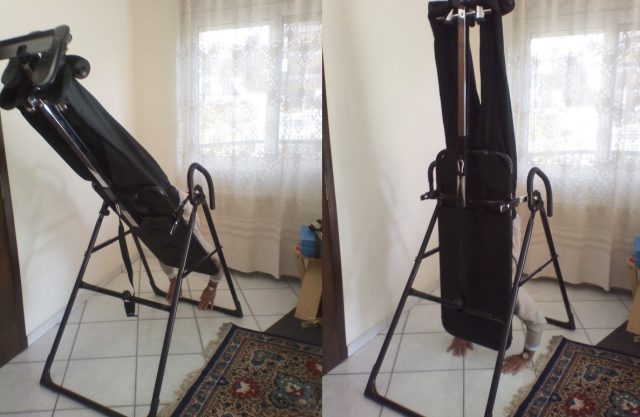Inversion therapy is a treatment that uses gravity to relieve pressure from the spinal column. It’s also known as “upside down” or “headstands” inversions because it involves lying on your back and using gravity to head up toward the ceiling.
There are many benefits to inversion therapy, such as improved posture, increased circulation, reduced lower back pain, and less muscle tension throughout the body. In this post, we will discover what you need to know about inversion therapy so you can decide if it could be right for you!
Inversion therapy and its functionality:
As we saw, inversion therapy is a therapy that can be used as a form of treatment. It aims at relieving pressure from the spinal column by using gravity to head towards the ceiling in a “headstand” position, so it is also known as upside-down or headstand therapy.
Inversion therapy occurs when you lie on your back with feet elevated and then arching backwards such that you are inverted (upside-down). You will need an apparatus for this type of exercise since there’s no way to do it without assistance – we recommend using either an inversion table or chair/bench specifically designed for inverting exercises.
The functionality of this technique is to reduce pressure on the discs and joints of your spine and improve circulation. It also assists in relieving muscle tension throughout the body thanks to gravity working against muscular force.
The benefits of inversion therapy:
There are many benefits of inversion therapy, such as:
- Improved posture:
Inversion therapy helps to improve your posture by stretching the back muscles, which reduces slouching. When we go upside down, this means gravity has less work to do with helping keep everything aligned and that allows your body’s natural alignment mechanisms (think of them as a bunch of rubber bands) to take over and make sure everything stays where it should be – no more slouching or hunching over!
- Increased circulation: Gravity helps blood flow in areas of the body that are compressed due to poor sitting or standing posture. There are two common benefits when it comes to increased circulation. The first is improving overall respiratory health since blood flow improves, which helps transport oxygen through the lungs into your bloodstream. Second, increased circulation in the limbs helps reduce swelling because better blood flow will lead to less fluid retention.
- Reduced lower back pain:
The spine is made up of 24 vertebrae with discs between each one, and when they’re under pressure, it can result in painful symptoms such as sciatica, pinched nerves, narrowed spinal canal etc. Inversion therapy relieves these pressures on a daily basis, so you don’t have any problems down the line. It’s also possible for this type of exercise to help reduce chronic lower back pain over time because there’s less tension in those muscles.
- Reduces muscle tension: Gravity is a natural muscle relaxant, which means inversion therapy can help your muscles release any tightness or knots that might be affecting them. The gravity-assisted stretching will also allow for the lengthening of shortened and overactive muscles, so you’re left with less pain all around!
- Improved mood:
Sitting upright all day might not be great for mental health either! When we sit or stand with good posture, there’s less tension on our spinal column and on other areas of the body. This will help improve both blood flow from head to toe as well as reduce any feelings of anxiety that might come along with feeling tense or stressed.
Equipment needed for inversion therapy:
You will find several inversion equipment in the market manufactured for different purposes. Here are some of the majorly used equipment for inversion therapy:
- Regular bed or exercise mat.
- Inversion chair.
- Yoga blocks for head support and the hands. You can also use pillows for foot supports.
The best equipment for you will depend on the areas that need attention most and your budget. You should also be clear about whether or not you want to use this for a long time since these are usually durable pieces of equipment which means they cost more than others. If possible, try out the different types of product reviews at https://www.proinversiontherapy.com before deciding!
How to get started with inversion therapy?
To start your inversion therapy regimen, make sure to follow these things:
- Clear your mind before and after you begin. Inversion therapy is about focusing on yourself, not what’s happening around you. This means that it’s important to find a space where you can get away from everything else for just five minutes at a time!
- Wear loose clothes or no pants at all, so there are minimal things restricting movement and broken blood vessels (can lead to increased circulation).
How often should I do an inversion?
This will depend on how much time you have available each day and how quickly your body responds to the treatment. Usually, people start with one session per week then move up gradually until they reach two sessions every day. Be mindful of your personal space and comfort levels when using an inversion table. You should practise inversions alone to maintain privacy so that no one can see the person’s face without their permission.
Who is it for?
Inversion therapy is most commonly used by those who have back pain, but there are also many other benefits: increased circulation, improved posture, reduction of muscle tension throughout the body. This means anyone with these conditions could benefit from this treatment! However, the risks will increase depending on how healthy someone already is because some people might not react well to inverting themselves upside down (i.e. heart problems).
Things to take care of while doing inversion therapy:
You need to make sure you don’t have any medical conditions before trying out this type of treatment! Here are some common things that could stop you from doing inversion therapy:
- If you suffer from migraines, high blood pressure, vertigo or chronic pain syndrome, it’s important to let your doctor know before practising inverted positions. There might be certain situations where doing an inverted position could trigger these symptoms again.
- Avoid inversion therapy if you suffer from frequent headaches, have a hernia or are pregnant.
- If you have a heart condition, it is important to let your doctor know before inverting because this type of therapy might not be appropriate for you!
In conclusion:
Inversion therapy is a great way to enhance your health naturally if done correctly without injury. It’s essential when engaging in an inverted position that there be something holding up the upper body so that there is no pressure on the neck. Always do this slowly and carefully to avoid any injuries!

A professional writer with over a decade of incessant writing skills. Her topics of interest and expertise range from health, nutrition and psychology.




